Not Just a Beauty Contest:
The Advantages of Proper
Structure for the Working Dog
by Ricardo E. Carbajal,
Chairman - USA Breed Advisory Committee
Why is conformation important to those
of us who are dedicated to the working ability of the
German Shepherd Dog? Why is the USA Sieger Show an integral
part of our program to develop and maintain the working
attributes of our breed? There is no answer more articulate
than this reprint from SchutzhundUSA's Jan/Feb '92 issue
by the head of USA Breed Advisory Committee.
When many people think of a good working dog, they
think of a specimen with stamina, high energy, strength
and power. Although these are qualities rooted in the
mind of a good GSD, too often we forget that the full
expression of these attributes depends on the physical
package in which it is wrapped. A car may have a finely-tuned
engine, but if the tires are flat and the allignment is
off, gas mileage will be greatly reduced. In the same
way a dog with good working drives but improper structure
cannot take advantage of it's hardware to perform to it's
fullest potential.
What is "Proper" Structure?
Simply stated, proper structure is the anatomical design
that offers the least resistance to movement. In other
words, certain physical advantages help one dog perform
a task using less 'gas' than other dogs not so well endowed.
These anatomical features are described in detail by judges
during conformation shows and breed surveys. However,
it is important to know not only what good conformation
is, but also why it is advantageous to a working dog.
To understand the why's of conformation, we must apply
scientific concepts (especially physics and kinetics)
to dog movement. There isn't room enough in this article
to discuss every aspect of GSD structure, but we can look
at one aspect (rear conformation) in depth as an example
of how proper structure affects the working dog.
The Science of Rear Conformation
Forward movement in dogs begins in the rear. The strength
of that movement or drive depends on how the rear assembly
is designed. In GSD's, rear assembly is defined in terms
of angulation, meaning the relative position of the bones
to each other during a certan phase of movement. When
we stack a dog for show in the typical "Shepherd
stance" we present the angulation of that dog during
two phases of movement.
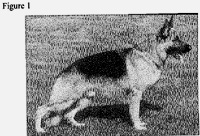
The leg retracted under the body shows
the angulation at the moment when the effective push forward
begins. The extended leg shows the position of the bones
when rear drive is about to end and the leg is lifted
off the ground in what is called follow through. The ideal
angles called for in most standards refer to those in
the retracted leg, and they are as follows:
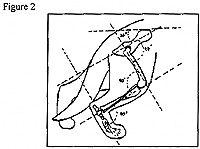
If that is true, why then do judges look
at the dog from the 'wrong' side, that of the extended
let? A correct dog with it's leg in the extended position
and hock perpendicular to the ground will show two sets
of parallel lines: the axis of the pelvic bone (croup)
parallels to the tibia (stifle), and the axis of the femur
(thigh) parallels to the metatarsus (hock).
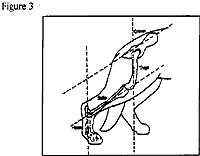
These parallel lines are intimately related
to angulation. Parallelism is retained through the entire
range of motion of the rear leg during the trot; when
the leg reaches the position under the body where it is
bearing the most weight and begins to push forward (see
figure 2), the bones are at right angles to each other
as called for the standard. The retracted leg can be stacked
adopting different angles, but the hock can fall perpendicular
to the ground in only one position. So, judges look at
the side that will not 'lie' to check for parallelism,
croup position, turn of stiffle and plumb lines. But is
it really true that efficient rear drive depends on the
prescribed angulation? Or is it just a capricious decistion
of those who control the evolution of the breed?
Ideal Angulation and Strength
Bones don't move by themselves. The position of bones
is important because it directly influences muscle action.
Muscle length and angle of insertion are primary factors
for efficiency. Long muscles are better suited for speed,
while short muscles provide greater strength. In GSD's,
muscles are neither very long (as in Greyhounds), nor
very short (as in Bulldogs), thus they provide a good
balance between speed and strength. The angle of insertion
of the muscle into the skeletal frame is most favorable
when the line passing through the muscle and tendon is
at a right angle to the bone upon which is acting. For
example, one of the main muscles contributing to rear
drive is the gastrocnemius, as shown in the following
illustration:
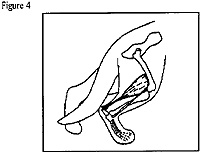
It attahes to the top of the hock through
the Achilles tendon. It's principle function is to open
the lower angle of the rear leg (formed by stiffle and
hock) thus producing a rear kick and forward thrust. In
a dog with correct angulation, the angle formed by the
tendon and hock at the time when the muscle contraction
is peaking, is an optimale 90 degrees. But what would
happen if we increase rear angulation? Most often, angulation
is increased when the tibia and fibula (stifle bones)
are lenghthened. When the stifle becomes longer, the dog's
weight automatically overcomes the strength of the ligaments
on all the rear joints. This is due to simple application
of physical principals of leverage.

The angle would be more easily bent using
the long lever shown on the left than with the short lever
shown on the right. Most overangulated dogs have stifles
that are much longer than their femurs, therefore the
longer 'lever' of the stifle overpowers the natural strength
of the joints, angulation is increased (becomes more acute),
and the dog 'sinks' under his own weight.
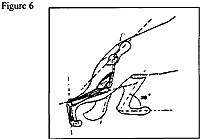
To open up the angle, the muscle is forced
to use greater strength.
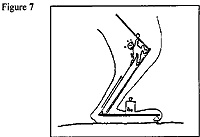
The lengthening of the stifle changes
the center of gravity of the dog, sliding it backwards
and placing greater stress on the lumbar area which is
not built to cope with it. It also lengthens the Achilles
tendon, reduces the power of the muscle, and above all,
disrupts the parallelism (see figure 6)
The Importance of Parallel Lines
Parallel lines offer the greatest advantage in rotational
force.
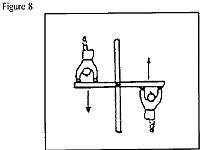
For the two people trying to rotate the
bars in the above ilustration, the greatest rotational
force is achieved when the lines in which they are moving
are parallel. Any deviation from the parallel directions
of push results in wasted energy. When the stifle and
croup are parallel to each other, full force is transmitted
by the rotation femur, through the croup, and into the
back, thus propelling the dog forward without wasting
energy.
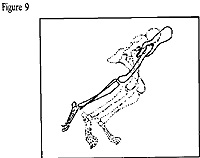
Parallel lines also ensure that the plumb
lines running through the hocks and femurs are both perpendicular
to the ground, offering great stability and correct center
of gravity (compare figures 3 and 6). The interaction
of parallel lines, correct angulation, good position and
length of croup, and strong, well-toned muscles creates
a very effective rear assembly capable of delivering the
most power in exchange for the least possible energy consumption.
The Future of Our Breed
Other aspects of proper conformation similarly affect
the working ability of the dog, especially those related
to the front assembly. Although many GSD fanciers remain
unaware of this intimate connection, working dogs enthusiasts
are nevertheless well-served by maintaining proper conformation
through continued judging of their dogs agains the breed
standard. Events such as the Sieger Show are much more
than a simple 'beauty contest,' they are an important
part of maintaining workability in our dogs.
A good GSD is a micracle of careful design and genetic
engineering -- body and mind working together as a well-oiled
machine. We have many events to help us evaluate mental
qualities. Let's protect the heritage that has been entrusted
to us as breeders and competitors and pursue more eagerly
the second half of the equation -- conformation -- demanding
fullness of quality and a total dog.